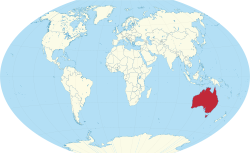Biology:Nymphaea hastifolia
| Nymphaea hastifolia | |
|---|---|
| Scientific classification | |
| Kingdom: | Plantae |
| Clade: | Tracheophytes |
| Clade: | Angiosperms |
| Order: | Nymphaeales |
| Family: | Nymphaeaceae |
| Genus: | Nymphaea |
| Species: | N. hastifolia
|
| Binomial name | |
| Nymphaea hastifolia Domin[1]
| |

| |
| Nymphaea hastifolia is native to the Northern Territory, and Western Australia[1] | |
Nymphaea hastifolia is a species of waterlily native to the Northern Territory, and Western Australia.[1]
Description
Vegetative characteristics
Nymphaea hastifolia is an annual or perennial aquatic herb[2][3][4] with globose rhizomes. The elliptical floating leaves with sinuate margins are 20 cm long, and 15 cm wide. The adaxial leaf surface is green, but the abaxial leaf surface displays purple colouration.[4]
Generative characteristics
The emergent flowers are white.[3][5] The seeds are ellipsoid or globoid.[2]
Reproduction
Generative reproduction
Flowering occurs from March to June.[2][3]
Taxonomy
Publication
It was first described by Karel Domin in 1925.[1]
Type specimen
The type specimen was collected by Schultz in Port Darwin, Australia.[6]
Placement within Nymphaea
It is placed in Nymphaea subgenus Anecphya.[7][8]
Etymology
The specific epithet hastifolia is derived from hasta, meaning spear, and folium, meaning leaf. It means having spear-shaped leaves.[9][10]
Conservation
It is not threatened.[3]
Ecology
Habitat
It occurs in lagoons,[11][12][13] peat bogs,[5] seasonally flooded grassland,[14] ephemeral billabongs, creeks,[3] and rivers.[15]
Use
The rhizome, roots, and seeds of Nymphaea hastifolia are used as food.[16][17]
References
- ↑ Jump up to: 1.0 1.1 1.2 1.3 "Nymphaea hastifolia Domin" (in en). Royal Botanic Gardens, Kew. http://www.plantsoftheworldonline.org/taxon/605575-1. Retrieved 1 January 2024.
- ↑ Jump up to: 2.0 2.1 2.2 Species: Nymphaea hastifolia. (n.d.). Atlas of Living Australia. Retrieved January 1, 2024, from https://bie.ala.org.au/species/https://id.biodiversity.org.au/node/apni/2897049#ausTraits
- ↑ Jump up to: 3.0 3.1 3.2 3.3 3.4 Western Australian Herbarium (1998–). Florabase—the Western Australian Flora. Department of Biodiversity, Conservation and Attractions. https://florabase.dbca.wa.gov.au/browse/profile/13915 (Accessed 2 January 2024).
- ↑ Jump up to: 4.0 4.1 Elliot, W. R., Jones, D. L. (1981). "Encyclopaedia of Australian Plants Suitable for Cultivation: N-Po." p. 47. Australien: Lothian Publishing Company Pty. Limited.
- ↑ Jump up to: 5.0 5.1 Magdalena, C. (2017). "The Plant Messiah: Adventures in Search of the World’s Rarest Species." Vereinigtes Königreich: Penguin Books Limited.
- ↑ Type of Nymphaea hastifolia Domin [family NYMPHAEACEAE]. (n.d.). JSTOR. Retrieved January 2, 2024, from https://plants.jstor.org/stable/10.5555/al.ap.specimen.k000659160
- ↑ Borsch, T., Hilu, K. W., Wiersema, J. H., Löhne, C., Barthlott, W., & Wilde, V. (2007). "Phylogeny of Nymphaea (Nymphaeaceae): evidence from substitutions and microstructural changes in the chloroplast trnT-trnF region." International Journal of Plant Sciences, 168(5), 639-671.
- ↑ Löhne, C. (2007). "Molecular Phylogenetics and Historical Biogeography of Basal Angiosperms (Doctoral dissertation, Universitäts-und Landesbibliothek Bonn)."
- ↑ Dioscorea hastifolia. (2021, September 16). Friends of Queens Park Bushland | Protect & Regenerate Bushland. Retrieved January 2, 2024, from https://www.friendsofqueensparkbushland.org.au/dioscorea-hastifolia/
- ↑ Ilieva, I. A. (2023). "Specific botanical epithets meaning likeness."
- ↑ Lamche, G. (2007). "THE LAGOONS OF THE OUTER DARWIN AREA, NT."
- ↑ LAMCHE, G., & SCHULT, J. (2012). "MACROPHYTE VEGETATION OF SIX LAGOONS IN THE DARWIN REGION, NT."
- ↑ Lamche, G., Schult, J., & Estbergs, A. (2008). "Trialing a Framework and Indicators for Wetland Extent, Distribution and Condition at the Regional Level."
- ↑ Finlayson, C.M., Cowie, I.D., Bailey, B.J. (1990). Characteristics of a Seasonally Flooded Freshwater System in Monsoonal Australia. In: Whigham, D.F., Good, R.E., Kvet, J. (eds) Wetland Ecology and Management: Case Studies. Tasks for vegetation science, vol 25. Springer, Dordrecht. https://doi.org/10.1007/978-94-009-2115-3_18
- ↑ Keighery, G. (n.d.). "Protecting the Kimberley's unique flora."
- ↑ Gil Hardwick, Economically Useful Plants for Northern Australia: Master Species List, August 2001, http://ebookswest.com.au/northern_species_list.pdf
- ↑ Vigilante, T., Toohey, J., Gorring, A., Blundell, V., Saunders, T., Mangolamara, S., ... & Doohan, K. (2013). "Island country: Aboriginal connections, values and knowledge of the Western Australian Kimberley islands in the context of an island biological survey." Records of the Western Australian Museum Supplement, 81, 145-181.
Wikidata ☰ Q17253174 entry
 |

